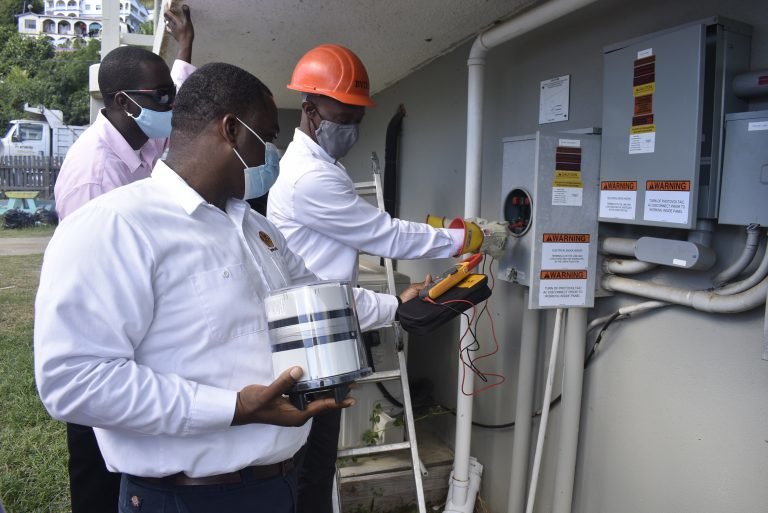
Youth Empowerment Project gets first grid-tied solar panels on Tortola
YEP now joins the Bregado Flax Educational Centre on Virgin Gorda as the only two buildings in the territory that have been approved to make this grid-tie connection, though Dana Miller, who led the YEP project, hopes that others will soon follow.
“It sets the precedent for permits, regulations and inspections,” said Mr. Miller, who owns the solar company aTec.
Upon passing the inspection last Thursday, the building was outfitted with a feed-in-tariff meter that tracks how much electricity the panels generate and how much electricity YEP feeds back into the grid.
Energy will only start to flow back into the grid once the panels produce their maximum capacity of 9.6 megawatts, said Mcgregor Williams, the head of BVIEC’s Electrical Inspection Unit.
And if BVIEC experiences a power outage, YEP will still be able to draw enough energy from its solar panels to keep the building’s lights, air conditioning, and other “critical loads” running, Mr. Williams explained.

Pricing structure
Currently, YEP’s feed-in-tariff — the amount the organisation is paid per-kilowatt hour it exports into the grid — is ten cents less than what it would pay if buying the electricity from the BVIEC, Mr. Miller said.
Because of this pricing structure, it is currently more economical for the non-profit to produce just enough energy to offset its consumption, rather than to produce excess that can then be exported back into the grid Mr. Miller said.
“If you’re offsetting all of your power, you’re gonna get a much better value for that rather than trying to overproduce and push back into the grid,” he added.
If YEP were to consistently produce more electricity from its solar panels than it needs, it would take eight to nine years to recoup its investment from purchasing the panels in the first place, Mr. Miller said.
If the organisation were to produce just enough to cover costs, however, it could recoup that investment in six or seven years, he said.
Still, by having the ability to export power back into the BVIEC’s grid, YEP’s solar system will play an instructive role in showing how the territory’s renewable energy regulations actually affect renewable energy projects, Mr. Miller said.

Import duties
In other countries, such as the United States, where many states offer tax or utility incentives for businesses or homeowners who go solar, the amount of time it takes to make back your investment in purchasing solar panels is much shorter, Mr. Miller said.
A first step the VI can take to increase the profitability of owning solar panels here is to drop the import duties on renewable energy technologies, he said.
Premier Andrew Fahie has previously said that his administration would discontinue these import duties, but Mr. Miller continues to pay them, he said.
Previous inspections
ATec installed the solar panels on YEP’s roof in 2019, but the system failed an inspection after applying to have the grid-tie interconnection approved.
The BVIEC’s Electrical Inspection Unit visited the site several times after for subsequent inspections, but it wasn’t until last Thursday that inspectors approved the entire system and gave Mr. Miller the signal to make the grid-tie connection for the first time.
Mr. Williams said his team last Thursday conducted “the testing phase,” in which they ensured that all components of the solar panels and grid-tie connection functioned safely.
According to Mr. Williams, YEP’s solar panels had failed previous inspections for not having proper signage or proper grounding, among other issues.
“Today was part of the last inspection … to make sure all safety aspects are in place,” Mr. Williams said.










